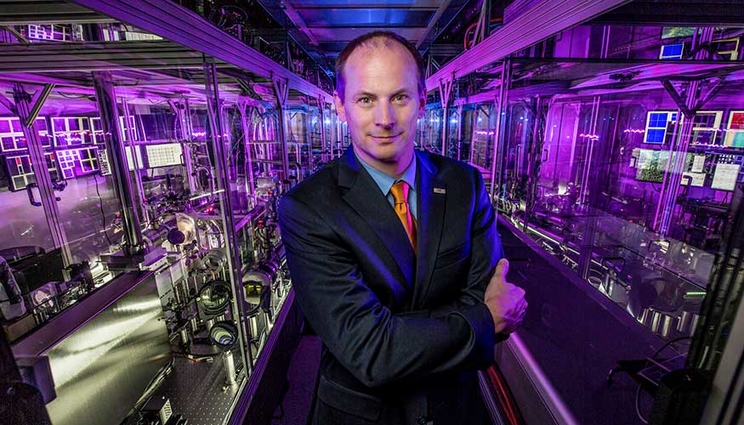Haefner elected fellow of Optical Society
 (Download Image)
Constantin Haefner, program director for Advanced Photon Technology at Lawrence Livermore National Laboratory, has been elected a fellow of The Optical Society of America. Photo by Jason Laurea/LLNL
(Download Image)
Constantin Haefner, program director for Advanced Photon Technology at Lawrence Livermore National Laboratory, has been elected a fellow of The Optical Society of America. Photo by Jason Laurea/LLNL
Constantin Haefner, program director for Advanced Photon Technology (APT) at Lawrence Livermore National Laboratory, has been elected a fellow of The Optical Society of America (OSA). Haefner was recognized for "pioneering next-generation, high-average-power petawatt laser systems enabling a new arena of applications and sustained advancement of state-of-the art technologies in large-scale, high intensity, peak-power laser systems."
Haefner has more than 15 years of experience in developing and delivering energetic solid-state laser systems for laboratory high energy density (HED) physics research. He is an internationally respected expert for solid-state, high-average-power and high peak-power laser development and systems engineering. As APT program director in LLNL’s NIF & Photon Science Directorate, he leads the research and development of advanced laser systems and technologies in support of national security missions, and scientific and industrial applications.
Energetic solid-state laser systems are used in a variety of research areas, such as inertial confinement fusion (ICF), material physics and high energy density physics (HED). These lasers are used for delivering high laser pulse energies in the joule to megajoule (MJ) range in a very short time to a target, creating extremely high temperatures, pressures and fields comparable to the inside of the sun. Specifically, when interacting with matter, high-energy, high-peak-power laser systems generate high-brilliance X-ray sources or particle beams with unique characteristics -- also known as secondary sources. These are utilized for diagnostics in HED and ICF, high-resolution imaging of dense objects, imaging of ultrafast processes in nature and other applications. They are gaining increasing interest for potential industrial and medical applications such as non-destructive-evaluation of objects, national security missions, production of nuclear tracers relevant to medical imaging techniques, hadron cancer therapy, X-ray imaging at reduced dose for the patient and many others.
The technical challenge for the design, construction and operation of these lasers is enormous and is pushing laser technology to its limits. Recently, the program developed and constructed the High-repetition-rate Advanced Petawatt Laser System (HAPLS) for the European Extreme Light Infrastructure Facility in the Czech Republic. HAPLS is the first diode-pumped laser system in the world capable of running 10 hertz and delivering petawatt pulses with a photon flux of 1.1 megajoules per hour, opening the door to exploring real-world applications and precision science.
Haefner joined LLNL in 2006 and focused his research on developing state-of-the-art short-pulse laser systems and technologies for the NIF & Photon Science Directorate. He has served as the chief scientist for the Advanced Radiographic Capability (ARC) multi-kilojoule laser system and developed the technologies for several ARC subsystems. Before joining LLNL, he was chief laser scientist at Nevada Terawatt in Reno, Nevada, where he led the design and development of high-energy multi-terawatt laser systems for HED physics research.
Haefner received his degree in physics in 1999 from the University of Constance, Germany, and his Ph.D. in laser physics in 2003 from the University of Heidelberg, Germany.
"It is a great honor to be elected a fellow of the Optical Society of America and to join such a prestigious group," Haefner said. "It reflects great credit on the work we do at LLNL, and I have been fortunate to collaborate with a truly amazing, dedicated and incredibly talented team – instrumental in our pursuit of cutting-edge laser technology."
Founded in 1916, OSA is the leading professional association in optics and photonics, home to accomplished science, engineering and business leaders from all over the world. Fellow membership in OSA is limited to no more than 10 percent of the membership and is reserved for members who have served with distinction in the advancement of optics and photonics.
Contact
 Breanna Bishop
Breanna Bishop
[email protected]
(925) 423-9802
Related Links
The Optical Society of America (OSA)National Ignition Facility & Photon Science
Advanced Photon Technologies
Tags
Lasers and Optical S&TLasers
National Ignition Facility and Photon Science
Careers
Featured Articles







